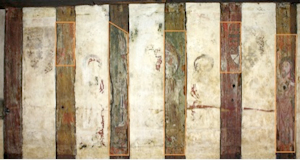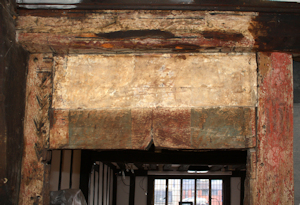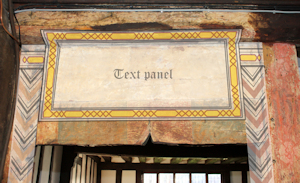
Mark Perry and Richard Lithgow identified two later schemes of painting overlaying the medieval scheme in the Guildhall chapel. At some point during the later part of the 16th or early 17th century, both the south and east walls of the former guild chapel were repainted with a decorative scheme of alternating vertical stripes of red and yellow ochre (Lithgow and Perry 2014, 6, 11; fig. 28). There is no evidence of the paint continuing over the infill panels, which were probably whitewashed at this period (Lithgow and Perry 2014, 6; Lithgow and Perry 2016, 17). This raises interesting questions about exactly how the paintings were treated in the mid-16th century, when the impact of the Reformation was first felt in Stratford-upon-Avon (Gill 2012a; Bearman 2007; 2012). Were they initially coated with a fine limewash, or perhaps more controversially, initially covered over by striped textile hangings, and only painted over later in the century, as in the adjacent Guild Chapel?

Analysis revealed that the east wall of the guild chapel had also been repainted at a later date, possibly in the 17th or even the 18th century (Lithgow and Perry 2016, 17). The ogee-headed doorway into the former Council Chamber was surmounted by a cartouche border and rectangular panel of text, with chevron designs extending down both sides of the posts forming the doorway itself (Figure 29a-b).The text panel border is embellished with a crudely painted red and yellow ochre lozenge pattern, while some of the chevrons are buff-coloured. The bresummer above the doorway is decorated with a buff-coloured scrollwork frieze on a white limewash ground edged in black (Lithgow and Perry 2016, 17) Although this is subtly different in style from the text panel border, it may well be part of the same scheme. The red and yellow ochre on the east wall is similar to the latest phase of painting on the south wall, which consists of an irregular wavy band of paint applied approximately 1m from the main image on the south wall, possibly associated with a shelf fixed against this wall


Internet Archaeology is an open access journal based in the Department of Archaeology, University of York. Except where otherwise noted, content from this work may be used under the terms of the Creative Commons Attribution 3.0 (CC BY) Unported licence, which permits unrestricted use, distribution, and reproduction in any medium, provided that attribution to the author(s), the title of the work, the Internet Archaeology journal and the relevant URL/DOI are given.
Terms and Conditions | Legal Statements | Privacy Policy | Cookies Policy | Citing Internet Archaeology
Internet Archaeology content is preserved for the long term with the Archaeology Data Service. Help sustain and support open access publication by donating to our Open Access Archaeology Fund.